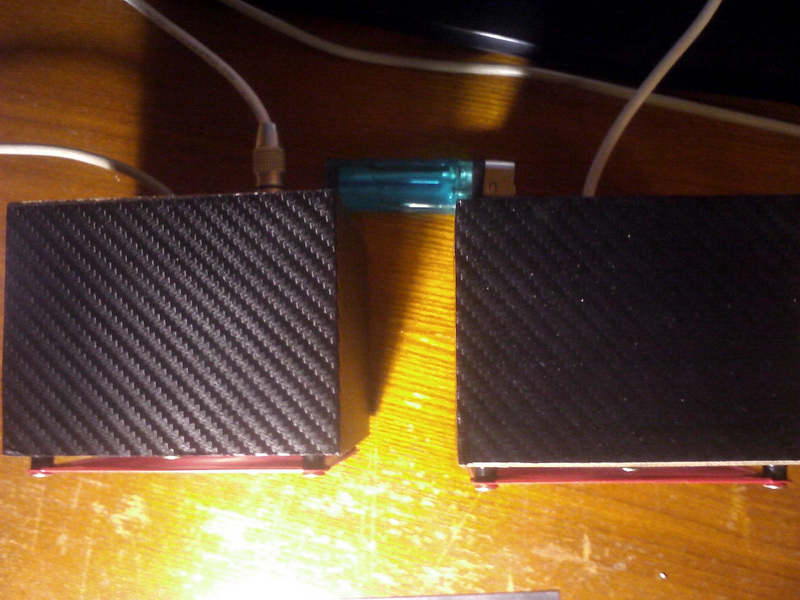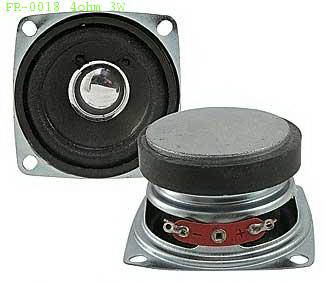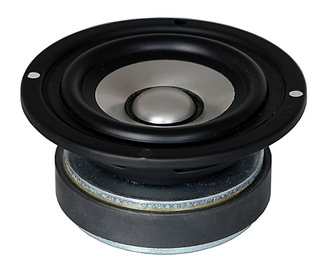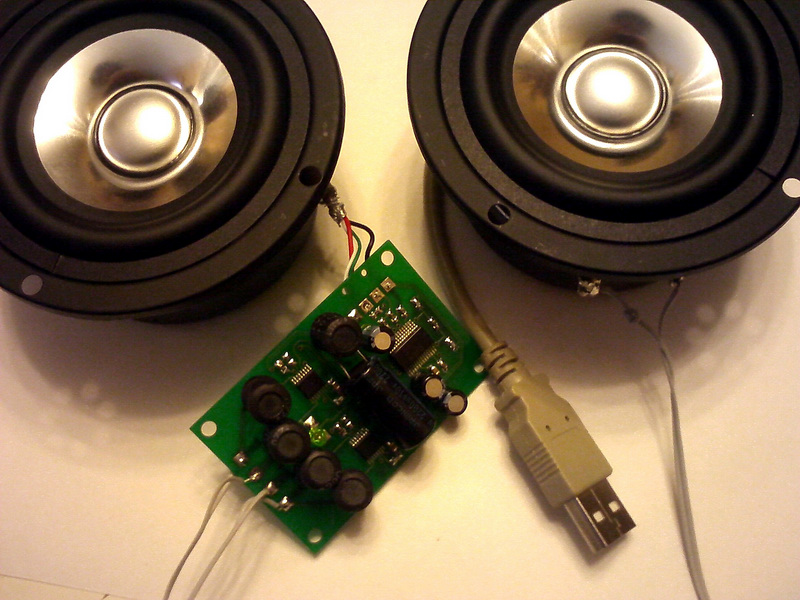Multimedia speakers for netbook
Soon the holiday season begins, the very time for which a laptop or netbook often becomes the main computer. And also, often, you want to have a little better sound than the built-in speaker similarity allows ...

As for the device described below, I solved this problem for myself. I will warn you in advance that the budget here turns out to be quite different from that of market products, but also the exact same difference in sound quality. The entire element base is easy to get in our country, you have enough time to wait for the parcels and assemble the device before you go to warm countries.
Technically, the amplifier only works from a single USB-connector (2.5 W), which imposes very large restrictions on the output power. Having 1.25 watts per channel, as a maximum, it is possible to apply only class D, moreover, in bridge switching. These chips are already producing American industry in the face of Texas Instruments, I personally stopped at TPA2000D1 . For this device, rather high parameters are indicated, only in a situation with limited power they turned out to be somewhat different. What is the result:
Sinusoidal power .................................... 1.1 W
Peak power (due to capacitor) ................ 1.7 W
Sizes ................................................. ....... 105 * 100 * 82
Weight................................................. .1580 grams (pair)
Distortion and frequency range is not really measured.
Also used is the popular and good PCM2704 DAC , which simultaneously controls the _SHUTDOWN amplifier mode.
')

The acoustics were designed specifically for travel, so the size was of paramount importance, of course, with the maximum demands for quality. As a result, the body is made of 10-mm MDF, plastered with vinyl film for cars, and a 90-mm grill for computer fans is used as a grill. Cases are filled with "audiophile" sintepon.
The situation with the acquisition of small broadband speakers for the sane money we have today is deplorable. Below is a description of 3 actually tried models. Taking into account such power, the amplifier does not tolerate 4-ohm speakers as it turned out during the tuning process.
FR-0018 4ohm 3W

Typical Chinese creation, no sensitivity, no sound. Very low price.
Visaton FR 7/4

Sensitivity: 86 dB
Range: 130–20000 Hz
Resistance: 4Ω
In my opinion, the best in the category in terms of the subjective sensations of listening. Suddenly, a fairly wide panorama and resolution. To get adequate volume, you should use a serial connection. Of course, this increases the size of the body ...
Fountek FE85

Sensitivity: 85.7 dB
Range: 100–25000 Hz
Resistance: 6Ω
The option that was chosen final. This power develops with him. More bass than the Visaton, but less resolution. Aluminum diffuser.

I would call it a big plus that you can get a loud and undistorted sound from the device, which is enough for everyday use even in the city. Is it possible to distinguish FLAC from MP3 - instantly. Of course, the disco will not work. Naturally, it is impossible to obtain any tangible bass from the reducible construction, with “full-scale” acoustics, completely different results are obtained, there is enough baseboard. There was a real opportunity to compare acoustics with existing plastic products, of course, not in their favor. There is no such effect when the acoustics begin to "pop and fall apart."

The amplifier has an on-board gain level control (4, 5 output), in my case it is set to the “12 dB” position, which gives a volume margin for silent recordings. With this gain, full power is achieved when the volume control is set to “-6 dB” (for example, you can assign hot keys to this position in Foobar2000 ). Attention, the adjustment is made by the “analog” method (through the OU feedback), make sure that there is nothing superfluous around these elements in the case of the own wiring of the board. Also, be careful with the frequency setting chain (13, 14 pin), as the poor quality of the installation leads to a peep from the speakers. The fuse used is self-healing, so a value of 300 mA is quite adequate.

As for possible modifications that can be made by anyone, I can recommend several things. I personally found them redundant.
Source code to take here

As for the device described below, I solved this problem for myself. I will warn you in advance that the budget here turns out to be quite different from that of market products, but also the exact same difference in sound quality. The entire element base is easy to get in our country, you have enough time to wait for the parcels and assemble the device before you go to warm countries.
Technically, the amplifier only works from a single USB-connector (2.5 W), which imposes very large restrictions on the output power. Having 1.25 watts per channel, as a maximum, it is possible to apply only class D, moreover, in bridge switching. These chips are already producing American industry in the face of Texas Instruments, I personally stopped at TPA2000D1 . For this device, rather high parameters are indicated, only in a situation with limited power they turned out to be somewhat different. What is the result:
Sinusoidal power .................................... 1.1 W
Peak power (due to capacitor) ................ 1.7 W
Sizes ................................................. ....... 105 * 100 * 82
Weight................................................. .1580 grams (pair)
Distortion and frequency range is not really measured.
Also used is the popular and good PCM2704 DAC , which simultaneously controls the _SHUTDOWN amplifier mode.
')
Constructive

The acoustics were designed specifically for travel, so the size was of paramount importance, of course, with the maximum demands for quality. As a result, the body is made of 10-mm MDF, plastered with vinyl film for cars, and a 90-mm grill for computer fans is used as a grill. Cases are filled with "audiophile" sintepon.
The situation with the acquisition of small broadband speakers for the sane money we have today is deplorable. Below is a description of 3 actually tried models. Taking into account such power, the amplifier does not tolerate 4-ohm speakers as it turned out during the tuning process.
FR-0018 4ohm 3W

Typical Chinese creation, no sensitivity, no sound. Very low price.
Visaton FR 7/4

Sensitivity: 86 dB
Range: 130–20000 Hz
Resistance: 4Ω
In my opinion, the best in the category in terms of the subjective sensations of listening. Suddenly, a fairly wide panorama and resolution. To get adequate volume, you should use a serial connection. Of course, this increases the size of the body ...
Fountek FE85

Sensitivity: 85.7 dB
Range: 100–25000 Hz
Resistance: 6Ω
The option that was chosen final. This power develops with him. More bass than the Visaton, but less resolution. Aluminum diffuser.
Real operation, setting

I would call it a big plus that you can get a loud and undistorted sound from the device, which is enough for everyday use even in the city. Is it possible to distinguish FLAC from MP3 - instantly. Of course, the disco will not work. Naturally, it is impossible to obtain any tangible bass from the reducible construction, with “full-scale” acoustics, completely different results are obtained, there is enough baseboard. There was a real opportunity to compare acoustics with existing plastic products, of course, not in their favor. There is no such effect when the acoustics begin to "pop and fall apart."

The amplifier has an on-board gain level control (4, 5 output), in my case it is set to the “12 dB” position, which gives a volume margin for silent recordings. With this gain, full power is achieved when the volume control is set to “-6 dB” (for example, you can assign hot keys to this position in Foobar2000 ). Attention, the adjustment is made by the “analog” method (through the OU feedback), make sure that there is nothing superfluous around these elements in the case of the own wiring of the board. Also, be careful with the frequency setting chain (13, 14 pin), as the poor quality of the installation leads to a peep from the speakers. The fuse used is self-healing, so a value of 300 mA is quite adequate.

As for possible modifications that can be made by anyone, I can recommend several things. I personally found them redundant.
- The system volume control buttons connected to PCM2704.
- A headphone jack with a splitter (5-pin) between the DAC and amplifiers, as usually PCM2704 sounds much better than the built-in sound cards. Of course, in this case, the output filter scheme should use the classic one.
- The use of “sound” capacitors as pass-throughs (C12, C13, C14, C15) and at the outputs of the PCM2704 power stabilizers (C5, C7, C8, C9), which improves the sound quality.
- Frequency generator with a stabilizer of 3.3 V instead of quartz on 28 pin (C4, C6, R6 remove).
- The possibility of additional power for more power.
Source code to take here
Source: https://habr.com/ru/post/179313/
All Articles